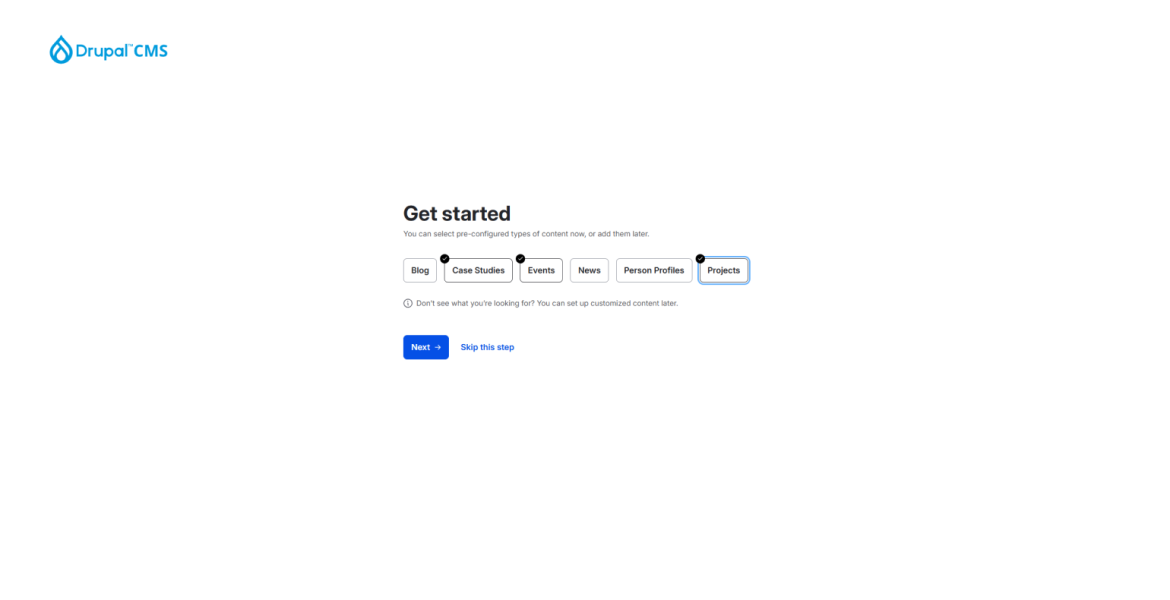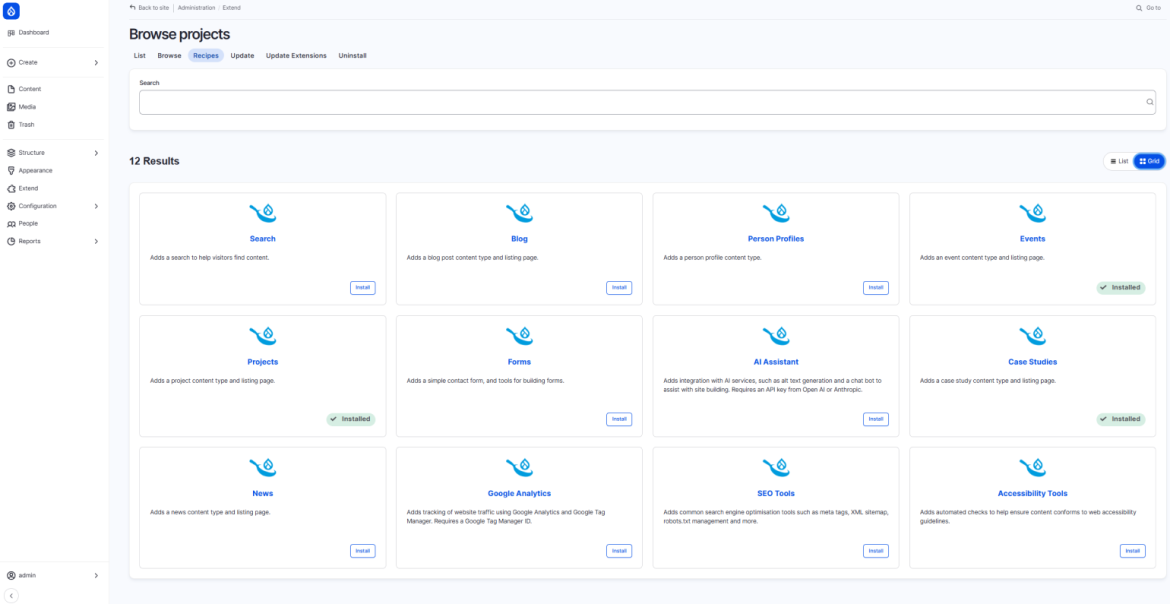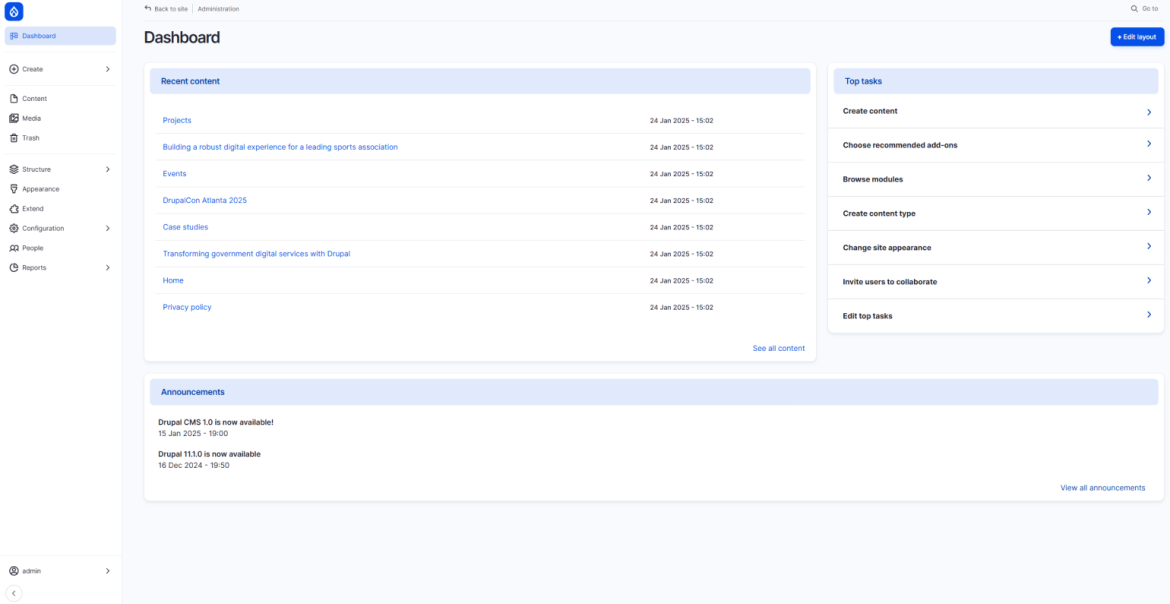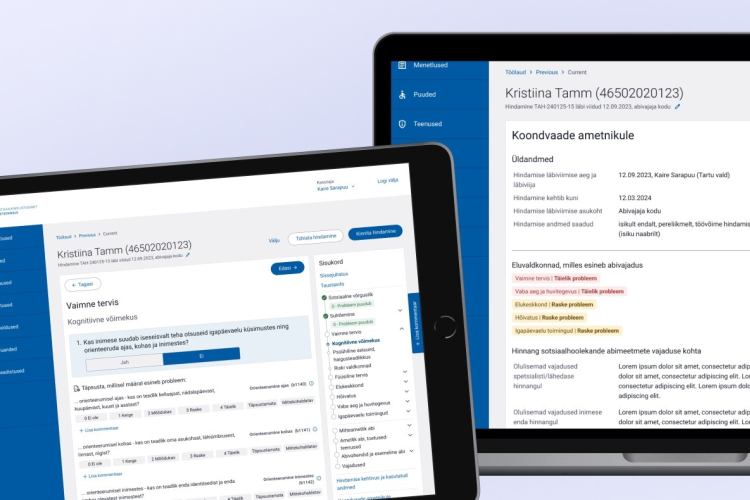Drupal CMS 1.0 – a new version or a new direction?
Feedback often suggests that Drupal is too complex — seemingly designed only for developers, or that "working with Drupal requires a PhD." Such perceptions spread quickly, creating the false impression that Drupal is outdated. This, in turn, may discourage potential users from adopting Drupal.
The Drupal umbrella organization is aware of these concerns and conducts regular user research and surveys. Since Drupal 8, the framework has undergone more frequent updates, with a strong focus on modernizing the user experience (UI and UX).
Our previous article discusses what makes a good user interface. These improvements have helped dispel the myth that Drupal is overly complicated and exclusively targeted at specialists.
At Trinidad Wiseman, we develop Drupal-based solutions ranging from simple websites to complex self-service portals and custom applications. We tailor Drupal to meet your business needs, ensuring a secure, well-integrated, and sustainable solution. Learn more about our Drupal-based services on our website and contact us for further information.
Drupal Starshot
Despite these advancements, progress has not been sufficient, as misconceptions persist, and Drupal's market share has not grown as rapidly as that of its competitors.
Recognizing the need for a more radical approach to demonstrating Drupal's capabilities and user-friendliness, the leadership of the Drupal umbrella organization, led by Drupal's creator Dries Buytaert, launched the Starshot initiative. The name was inspired by John F. Kennedy's speech setting the ambitious goal of landing humans on the Moon within eight years.
In spring 2024, Dries set the goal of launching Drupal Starshot within just eight months — on 15 January 2025, Drupal's 24th anniversary. They succeeded! The rapid and successful launch was driven by a well-thought-out strategy and effective project management, principles we explore in our article on how to launch successful projects quickly.
This milestone was celebrated with global launch events, marking both the birth of Drupal CMS and the official end-of-life of Drupal 7. After multiple support extensions, Drupal 7 lost all support on this date.
The Drupal CMS 1.0 version, launched on 15 January 2025, is the result of eight months of intensive work. However, this is just the beginning. Even Drupal's critics praise the new version, but the ultimate goals are set for completion by spring 2027. Drupal CMS 1.0 is merely the first step in a three-year strategic plan.
Shortly before the 15 January deadline, Drupal Starshot was renamed Drupal CMS. Since many Drupal users had previously referred to Drupal's core as Drupal CMS, this change could cause some confusion. Nevertheless, it is now the official name of the product going forward.
Drupal as a leader in innovation
These are the words of Dries Buytaert, Drupal's creator. For those familiar with Drupal, the Drupal CMS initiative was no surprise—innovation has always been at Drupal's core. From its early days, Drupal earned a reputation as a forward-thinking and innovative content management system.
Drupal contributed to the emergence of Web 2.0 by offering functionalities such as blogging, RSS, and commenting before the term Web 2.0 even became widely known. Additionally, Drupal was the first content management system to adopt jQuery—a popular JavaScript framework that simplified web development and UI creation (read more about JavaScript).
Today's rapidly evolving business landscape requires organizations to continuously adapt and grow. Drupal is designed to meet changing business needs and support organizations on their long and challenging journeys.
Drupal Core and Drupal CMS
As of 15 January 2025, Drupal can be used to build web solutions in two distinct ways:
Drupal Core – Suitable for complex and highly customized solutions that require extensive developer involvement. It is ideal for building information systems and multisite web platforms where high adaptability and flexibility are necessary.
Drupal CMS – A ready-to-use product that requires minimal development work. It is easy to configure and comes with built-in tools such as advanced media management, SEO tools, AI-powered website building, consent management, analytics, search functionality, and more. Drupal CMS is built on the Drupal Core but optimized for quick deployment.
Empowering a diverse user base
Drupal CMS 1.0 puts Drupal's powerful tools in the hands of marketers, designers, and content creators, making Drupal accessible even to those without extensive expertise.
One of the primary target audiences for Drupal CMS is marketing teams, as they work most frequently with content management systems. Drupal CMS aims to simplify common marketing tasks such as SEO, social media content sharing, event promotion, traffic analysis, and newsletter subscriptions through built-in functionalities.
Many marketers prefer WordPress due to its simplicity. However, as businesses grow, this simplicity can become a limitation, reducing scalability, customization options, and architectural flexibility.
Drupal CMS, on the other hand, combines ease of use with superior built-in functionalities, greater flexibility, and scalability while maintaining a strong user experience (read more about usability and user experience). As the Drupal CMS strategy document states, Drupal CMS is a tool for ambitious marketers.
Drupal CMS setup. Selection of content type recipes.
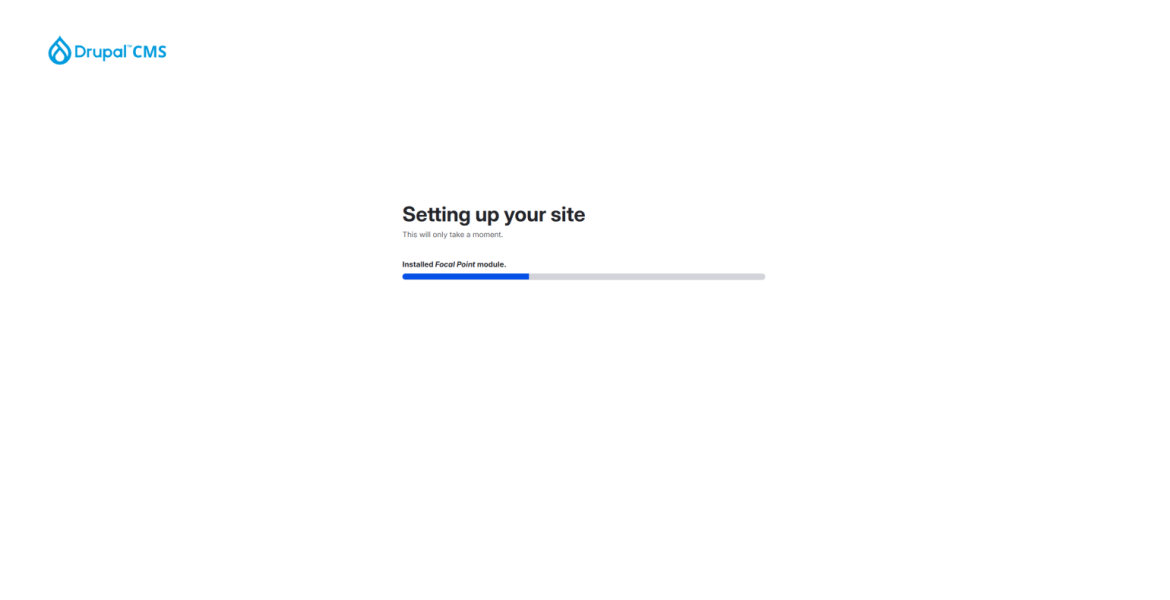
Installing the default Drupal CMS configuration.
Drupal Recipes
Drupal CMS 1.0 includes 30 Recipes, many of which are pre-configured to provide essential functionality that most websites need. The number of available recipes continues to grow.
Recipes not applied by default can be installed as optional add-ons either during setup or later via the new Project Browser, which allows users to add additional Drupal modules through a user-friendly interface.
Drupal Recipes are designed for both beginners and experienced Drupal users. Beginners can quickly set up a modern, UI/UX-friendly website with just a few clicks, launching a functional site ready for content creation. However, before starting development, it is recommended to identify critical business processes to create value and reduce waste.
Drupal CMS Recipes help save time and accelerate the delivery of complete solutions. But innovation doesn't stop there—Drupal also offers AI-driven agents specifically designed for site architecture modifications.
While AI is commonly used for content generation, Drupal's AI modules go further. For example, an AI chatbot can guide administrators through configuration changes, such as creating custom content types, setting up taxonomies, and more.
Retseptid
The Drupal CMS Dashboard provides a centralised administrative interface that can be customised to meet the needs of different user types, enhancing the overall user experience. Personalised dashboards can be configured for users by adding widgets that offer quick access to essential information and frequently used functionalities.
Dashboard
Experience Builder
The Experience Builder, set to be released at the end of 2025, will become Drupal’s primary tool for content display, replacing existing UI tools such as View Modes, Layout Builder, Blocks, and Views. This will allow content managers to edit all content using a single central tool.
Currently, content creators must navigate multiple UI views depending on the complexity of their content architecture. The Experience Builder will significantly simplify content management.
Designed based on a specially developed Stylebook, the Experience Builder aims to be powerful yet user-friendly for content creators, front-end developers, and designers. It enables them to create modern and visually engaging websites while leveraging Drupal's robust content architecture.
Why choose Drupal?
Organizations that do not use the Drupal framework often encounter scalability limitations over a project's lifecycle. A website that initially seems simple can evolve into a complex system, and if it is built on a platform with limited capabilities, expansion may become difficult or even impossible.
Drupal, with its API-first and entity-based architecture, is a strong player in the custom solutions market, offering high flexibility and adaptability (read more about the role of APIs in digital experiences). Unlike many other frameworks, Drupal is not designed for a single specific use case — it is a versatile tool suitable for various projects.
For projects requiring maximum flexibility and customization, Drupal Core is the ideal choice. However, for those looking for a quicker and more streamlined deployment, Drupal CMS can integrate its ready-made functionalities while maintaining Drupal's flexibility.
Both Drupal Core and Drupal CMS are free and open-source, ensuring long-term sustainability and adaptability to evolving business needs. Drupal CMS marks the next step in Drupal's 24-year journey, delivering even greater usability and flexibility.


